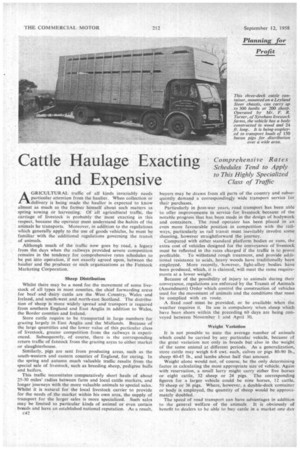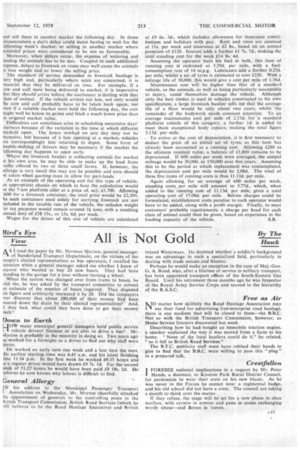Cattle Haulage Exacting and Expensive
Page 78

Page 81

If you've noticed an error in this article please click here to report it so we can fix it.
Comprehensive Rates Schedules Tend to Apply to This Highly Specialized Class of Traffic
AGRICULTURAL traffic of all kinds invariably needs particular attention from the haulier. When collection or delivery is being made the haulier is expected to know almost as much as the farmer himself about such matters as spring sowing or harvesting. Of all agricultural traffic, the carriage of livestock is probably the most exacting in this respect, because the operator must understand the-habits of the animals he transports. Moreover, in addition to the regulations which generally apply to the use of goods vehicles, he must be familiar. with the additional regulations governing the transit of animals.
Although much of the traffic now goes by road, a legacy from the days when the railways provided severe competition remains in the tendency for comprehensive rates schedules to be put into operation, if not exactly agreed upon, between the haulier and the producer or such organizations as the Fatstock Marketing Corporation.
Sheep Distribution Whilst there may be a need for the movement of some livestock of all types in most counties, the chief forwarding areas for beef and dairy cattle are the West-Country, Wales and Ireland, and south-west and north-east Scotland. The distribution of 'sheep is more widely spread and transport is required from southern England and East Anglia in addition to Wales, the Border counties and Ireland.
Store cattle require to be transported in.large numbers for grazing largely in East Anglia and the Midlands. Because of the large quantities and the lower value of this particular class of livestock, greater competition from the railways is experienced. Subsequently, of course, there is the corresponding return traffic of fatstock from the grazing areas to either market or slaughterhouse.
Similarly, pigs are sent from producing areas, such as the south-western and eastern counties of England, for curing. In the spring and autumn much valuable traffic. results from the special sale of livestock, such as breeding sheep, pedigree bulls and heifers.
This traffic necessitates comparatively short hauls of about 25-30 miles' radius between farm and local cattle markets, and longer journeys with the more valuable animals to special sales. Whilst it is natural for the local livestock carrier to provide fOr the needs of the market within his own area, the supply of transport for the larger sales is more specialized. Such sales may be limited to particular kinds of animal or even certain breeds and have an established national reputation. As a result, c42 buyers may be drawn from all parts of the country and subsequently dernand a correspondingly wide transport service tor their purchases.
Particularly in Post-war years, road transport has been able to offer improvements in service for livestock because of the notable progress-that has been made in the design of bodywork and containers. The road operator has been placed in an even more favaurable position in competition with the railways, particularly as rail transit must inevitably involve some shunting, however straightforward the journey.
Compared with either standard platform bodies or vans, the extra cost of vehicles designed for the conveyance of livestock must be reflected in the rates charged if the traffic is to prove profitable. To withstand rough treatment, and provide additional resistance to acids, heavy woods have traditionally been employed. More recently, however, light-alloy bodies have been produced, which, it is claimed, will meet the same requirements at a lower weight.
Because of the possibility of injury to animals during their conveyance, regulations are enforced by the Transit of Animals (Amendment) Order which control the construction of vehicles used for the movement of animals and the conditions that must he complied with en route. "
A fixed roof must be provided, or be available when the weather requires it. Its use is compulsory when sheep which have been shorn within the preceding 60 days are being conveyed between November 1 and April 30.
Weight Variation It is not possible to state the average number of animals which could be carried by any particular vehicle, because of the great variation not only in breeds but also in the weight of the same animal at different periods. As a generalization, store cattle may weigh 6-8 cwt. each, calves or pigs 80-90 lb., sheep 40-45 lb., and lambs about half that amount.
Weight alone would not, of course, be the only determining factor in calculating the most appropriate size of vehicle. Again with reservation, a small lorry might carry either five horses or eight cattle, 32 sheep or 24 pigs. The corresponding figures for a larger vehicle could be nine horses, 12 cattle, 50 sheep or 36 pigs. Where, however, a double-deck container or body is employed, the quantity of sheep would be approximately doubled.
The speed of road transport can have advantages in addition to the general welfare of the animals. It is obviously of benefit to dealers to be able to buy cattle in a market one day
tnd sell them in another market the following day. In those ircunistances. a day's delay amid mean having to wait for the 'ollowing week's market,or selling in another. market where Natential prices were considered to be not so favourable. Moreover,when delays occur, the expense of watering and 'ceding the animals has to be met. Coupled to such additional ixpense, delays to livestock en route may well cause the animals d lose weight and so lower the selling price.
The standard of service demanded in livestock haulageis fery high and,particularly where sales are concerned, it is
;ssential that they be delivered on time. For example, if a mw and calf were 'being delivered to market, it is imperative hat they should arrive before the auctioneer is dealing with that :lads of animal. If the vehicle arrives too late, not only would he cow arid calf probably have to be taken back • again; but wen if a suitable market were held the following day, the cow night well be below its prime and fetch a much lower price than
ts original market value.
Difficulties can sometimes arise in scheduling successive days Oneneys because of the variation in the time at which different narketi. open. The .hours -worked on any day may -not he. .Xcessive, but because of .a -late opening at a market,vehicles ire correspondingly late returning to depot. Some form of lounle-shifting of drivers may he necessary if the market the following day happens to open early. Where the livestock haulier is collecting animals for market n his own area, he may he able to make up the load from raffle offered by two or three small farms. If, however, the nileage is very small this may not be possible and note should ic taken whenT quoting rates to allow for part-loads. As an example of the operating cost for this type of vehicle in appropriate .chassis on which to base the calculation would )e the 7-ton platform oiler at a price of, saY, £1,700. Allowing 600 for a livestock container, the total price would be £2,300 ks such 'containers used solely for carrying livestock are no ncluded in _the taxable rate of the vehicle, the unladen weigh or tax purposes would remain around n tons, with a resulting innual duty of £38 I5s., or 15s. 6d, per week. —
Wages for the driver of this size of vehicle are calculated at £9 6s.-3d„ which includes allowance for insurance contributions and holidays with pay. Rent and rates are assessed at I Is. per week and insurance at £2 8s., based on an annual premium of £120. Interest adds a further £1 7s. 7d., making the total standing cost for the week £14 8s. 4d. Assuming the operator buys his fuel in bulk, this item of running cost is' reckoned at 3.29d. per mile, with a fuelconsumption rate of 14 m.p.g. Lubricants add a further 0.25d. per mile whilst a set of tyres is estimated to cost £220. With a mileage life of 30,000, this would give a cost per mile of 1.76d.
Maintenance cost will be higher than that of a standard vehicle, as the animals, as well as being particularly susceptible to injury, could themselves damage the vehicle. Although Only the best tiinber is used in vehicles constructed to his own specification, a large livestock haulier tells me that the average life of a floor would be only about two years, whilst the remainder of the bodywork needs constant attention. To an average maintenance cost per mile of 2.13d. for -a standard platform vehicle of this category, a further Id. is added to meet thege exceptional body repairs, making the • total figure
3.13d. per mile. . To arrive at the cost of depreciation,. it is first necessary to deduct the price of an initial set of tyres,as this Rent has already been accounted as a running cost. Allowing £280 as the ultimate residual value, a balance of £1,800 remains to be depreciated. If 600 miles per week were averaged, the annual mileage would be 30,000, or 150,000 over five years. Assuming this to be the period at which replacement was contemplated, the depreciation cost per mile would be 2.88d. The total of these five items of running costs is thus 11.13d. per mile. Again allowing for an average of 600 miles per week, standing costs per mile will amount to 5.77d., which, when added to the running cost of 11.13d. per mile, gives a total operating cost. of 17.08d. per mile. Before charges could be formulated, establishment costs peculiar to each operator would have to be added, along with a profit margin. Finally, to meet customers' probable requirements, a charge per head for each class of animal could then be given, based on experience in the loading capacity of the vehicle. S.B.
























































































































